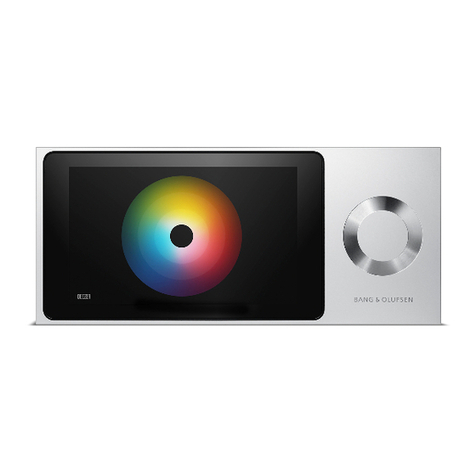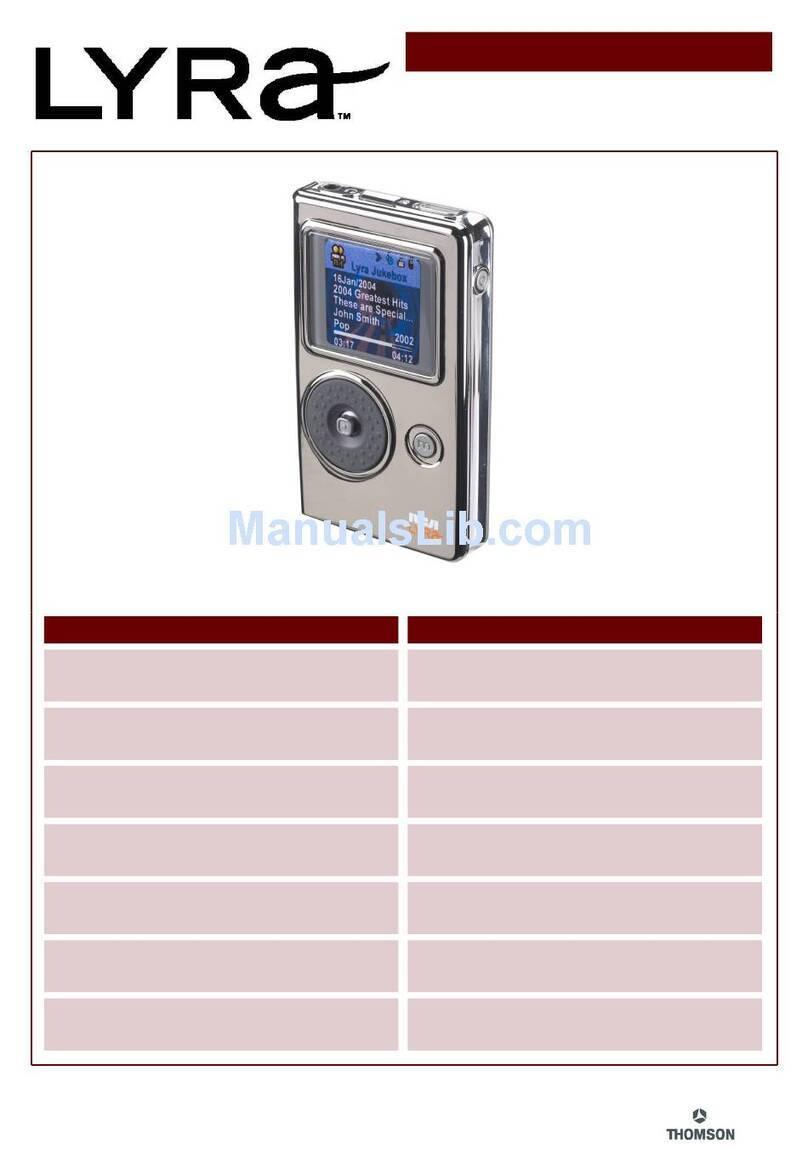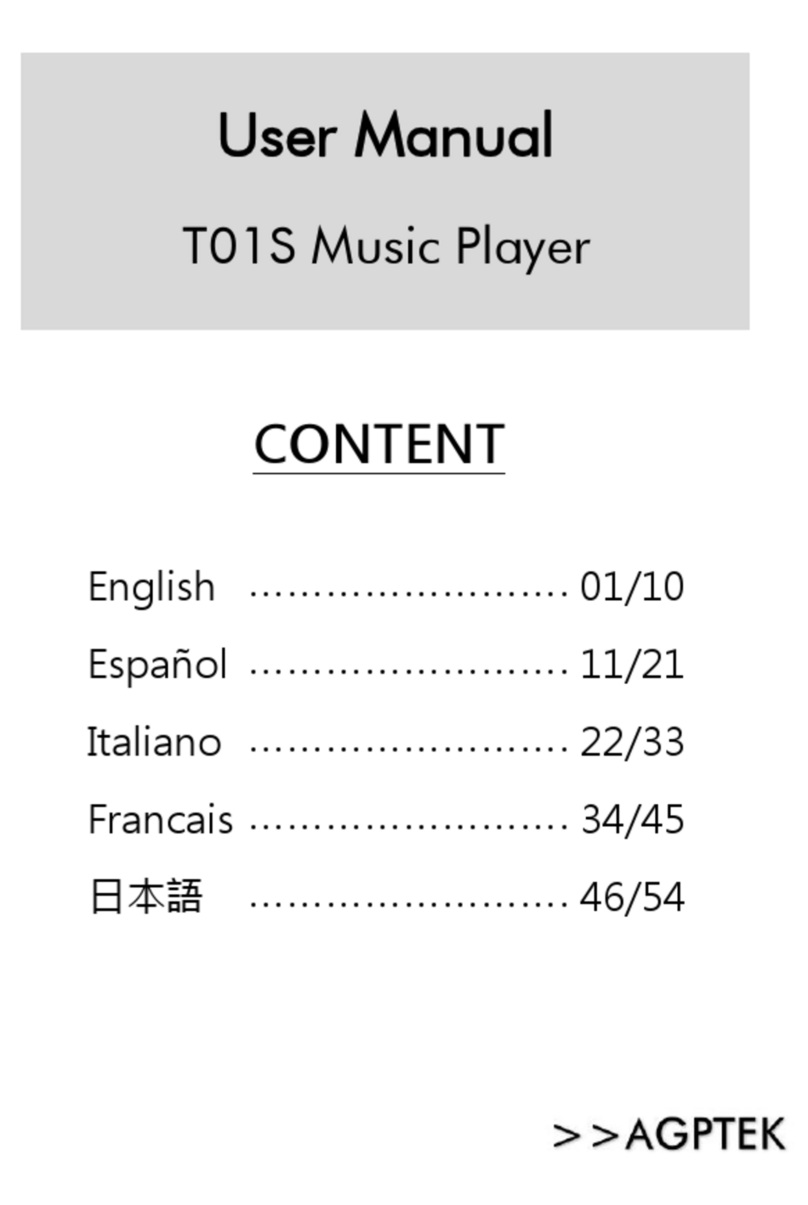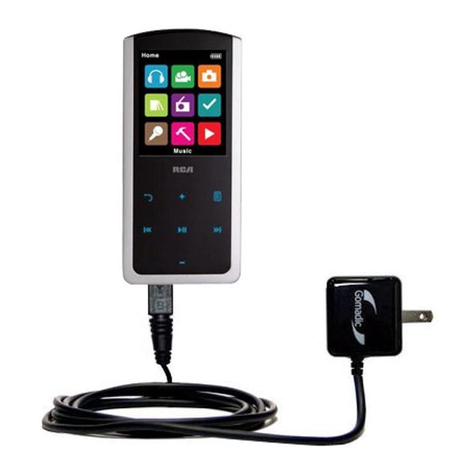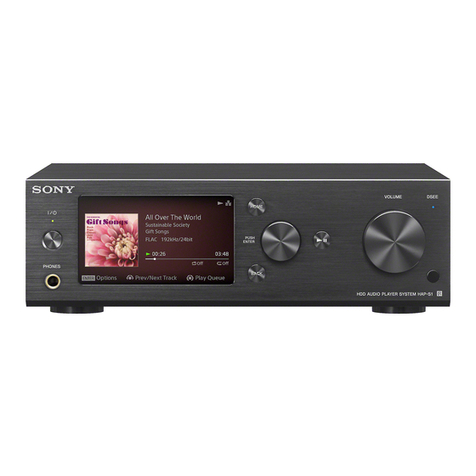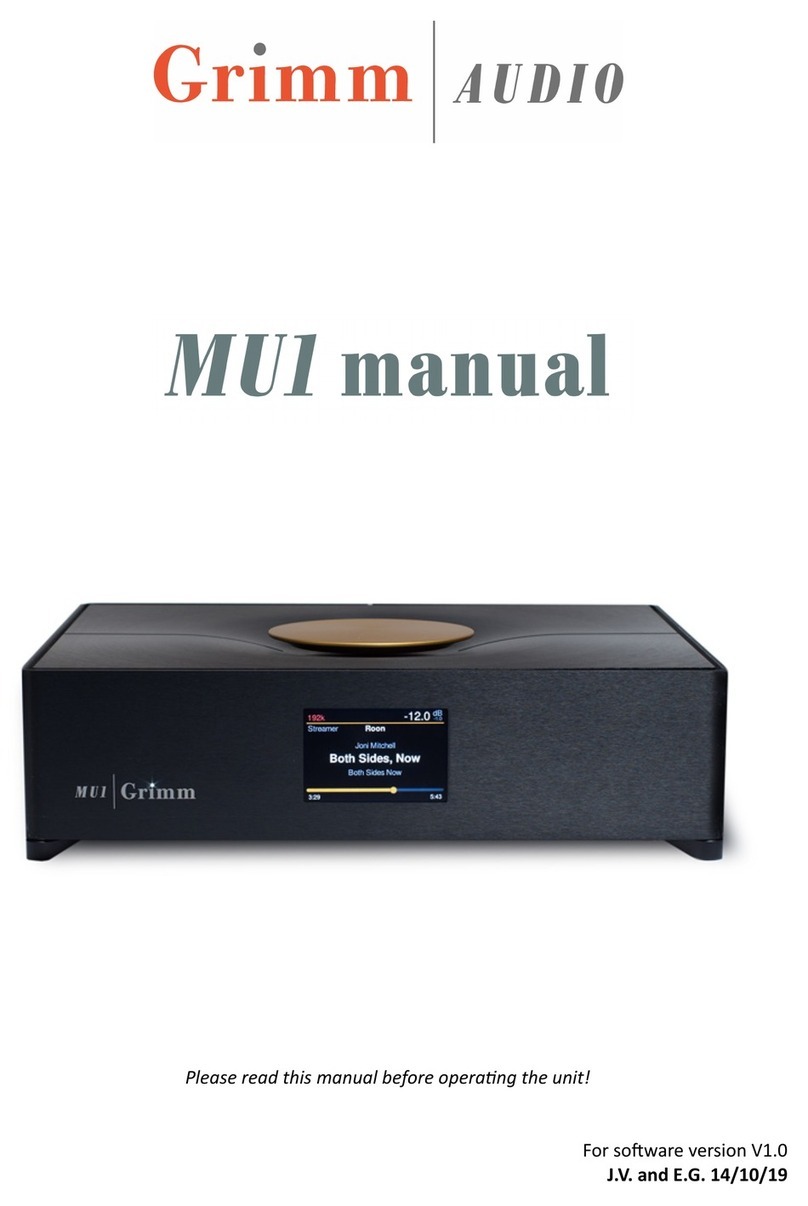Bang & Olufsen BeoSound 2 User manual

BeoSound 2
Guide

CAUTION: To reduce the risk of
electric shock, do not remove
cover (or back).
No User-serviceable parts
inside. Refer servicing to
qualified service personnel.
WARNING: To prevent fire or electric
shock, do not expose this appliance to
rain or moisture.
This symbol indicates that a
dangerous voltage
constituting a risk of electric
shock is present within this
unit.
This symbol indicates that
there are important
operating and maintenance
instructions in the literature
accompanying this unit.
This class B digital apparatus meets all requirements of
the Canadian Interference-Causing Equipment
Regulations.
NOTE: This device complies with part 15 of the FCC
Rules. Operation is subject to the following two
conditions: (1) This device may not cause harmful
interference, and (2) this device must accept any
interference received, including interference that may
cause undesired operation.
This equipment generates, uses and can radiate radio
frequency energy and, if not installed and used in
accordance with the instructions, may cause harmful
interference to radio communications. However, there is
no guarantee that interference will not occur in a
particular installation. If this equipment does cause
harmful interference to radio or television reception,
which can be determined by turning the equipment off
and on, the user is encouraged to try to correct the
interference by one or more of the following measures:
– Reorient or relocate the receiving antenna
– Increase the separation between the equipment and
receiver
– Connect the equipment into an outlet on a circuit
different from that to which the receiver is connected
– Consult the retailer or an experienced radio/TV
technician for help
This product fulfills the conditions stated in the EEU
directives 89/336 and 73/23.
For your safety: Keep the BeoSound 2 player and
docking station away from water and do not place items
on top of them. BeoSound 2 is developed for use in dry
environments only, and for use within a temperature
range of 5–45° C (41–113° F).
Technical specifications, features and the use
thereof are subject to change without notice!

3
Acknowledgements and liability
Product names mentioned in this guide may be
trademarks or registered trademarks of other
companies.
Portions utilize Microsoft Windows Media
Technologies. Copyright © 1999-2002 Microsoft
Corporation. All rights reserved. Microsoft, Windows
Media and the Windows Logo are registered
trademarks of Microsoft Corporation in the United
States and/or other countries.
MicroOS Operating System
(U.S. Patent #5,787,445)
Please note that Bang & Olufsen will, in no event, be
liable for any consequential, incidental or indirect
damages arising out of the use or inability to use the
software.
Mac, the Mac logo and iTunes are trademarks of
Apple Computer, Inc., registered in the U.S. and
other countries.
System requirements – PC
• One free USB port
If you connect the BeoSound 2 docking station to
this port via an external HUB, make sure that your
HUB supports Full Speed Devices.
• 10 MB of available disk space
• Windows 98/ME/2000/XP
You must have administrator privileges on
Windows 2000/XP to install the BeoSound 2
firmware.
System requirements – Macintosh
• One free USB port - 1.1
If you connect the BeoSound 2 docking station to
this port via an external HUB, make sure that your
HUB supports Full Speed Devices.
• MAC OS 9.x and OS X compatible
• iTunes 2 (and newer) compatible
Supported file formats
• MP3
Sampling frequencies: 8, 11.025, 12, 16, 22.05,
24, 32, 44.1, and 48 kHz
Constant or variable bit rates: 8, 16, 24, 32, 40,
48, 56, 64, 80, 96, 112, 128, 160, 192, 256 and
320 Kbps
• WMA
Sampling frequencies: 8, 11.025, 16, 22.050, 32,
44.1 and 48 kHz
Bit rates: 64, 80, 96, 128, 160 and 192 Kbps
• Note that the WMA format is not supported by
iTunes.
Check www.beoplayer.com to see whether new file
formats are supported by BeoSound 2. Updated
BeoSound 2 firmware will also be available on this
website.

4English
Setting up BeoSound 2
Follow the sequence below corresponding to your setup, PC or
Macintosh. If your computer is a PC, do not connect the USB cable until
you are specifically prompted to do so on the screen! If you have a
Macintosh computer, it is essential that you change mode, in the exact
fashion and sequence as described below.
Installation and connection (PC use)
1Insert the included memory card into BeoSound 2.
2Insert the CD-rom in your computer’s CD drive. If the Setup program starts
automatically, proceed to 5. Otherwise, go to 3.
3Select your CD drive.
4Double-click the ‘Setup’ file.
5Follow the on-screen instructions...
6When prompted on the screen, connect the USB cable to your computer.
Installation and connection (Macintosh use)
1Insert the included memory card into BeoSound 2.
2As BeoSound 2 is in BeoPlayer mode per default, you must change this
setting. Make sure that BeoSound 2 is paused and that the Earphones are
connected. Press and hold
∧
and
ss
. Then press GO twice, without letting
go of the first two buttons. You will receive audible feedback. Your
BeoSound 2 is now in iTunes mode.
3Connect the USB cable to your computer.
4Insert the CD-rom in your computer’s CD drive.
5Select the appropriate folder for your operating system, OS 9 or OS X.
6Select the install file, and follow the on-screen instructions…
Configuration and formatting (BeoPlayer use only)
Before you copy music to your BeoSound 2 from BeoPlayer, you may want to
set the copying quality or make other adjustments to the default settings. This
is all done by clicking SETUP on the BeoPlayer on-screen control bar, then
CONFIG – and a configuration menu appears where you can make your
changes. The configuration menu is also where you format a memory card.
Explore the configuration menu for yourself, or access the On-screen Guide
for an in-depth explanation.
B
A
Place BeoSound 2 on its docking
station as shown above.
Connect the USB cable – if your
computer is a PC, wait until you are
prompted.
USB

5
Get started
Once you have connected and installed BeoSound 2 to your computer,
you can begin using it. To find out how BeoSound 2 works with your
computer and music player, simply proceed to the section on the
following pages, describing the setup you have. Available options are
listed below.
BeoPlayer or BeoLink PC 2 (PC use only)
We recommend using BeoSound 2 with Bang & Olufsen’s own music players:
BeoPlayer or BeoLink PC 2. This Guide describes the basic use on the
following pages. To learn more about advanced use of BeoSound 2 with
BeoPlayer or BeoLink PC 2, refer to the On-screen Guide located at the
bottom of the on-screen control bar in both of these players. Find out for
example how to:
– Move or rename tracks and playlists in BeoSound 2.
– View and edit track INFO.
– Find out more about CDDB music information.
– Alter Configuration settings for a personalised touch.
– Format a memory card.
All future reference to BeoPlayer includes BeoLink PC 2 use, as these two
players work similarly regarding Beosound 2.
iTunes (Macintosh use only)
To learn more about using iTunes, refer to ‘BeoSound 2 with iTunes’ in this
Guide. For further information on iTunes, refer to the iTunes help function.
Other players
It is possible to use other players than the above mentioned with BeoSound 2.
Examples can be found in ‘other players and options’ on the last page of this
Guide.
Open the small compartment on the
back of BeoSound 2 to insert the
memory card.
Use a needle to access the key ring
attachment.
GO

6>> English
BeoSound 2 with BeoPlayer
Copy music files to BeoSound 2
The N.MUSIC organiser in BeoPlayer automatically sorts your music tracks by
Genre, Album, Title, Artists and Playlists. If you already have music stored in
N.MUSIC, you can start copying tracks to BeoSound 2.
> Place BeoSound 2 on the docking station.
The docking station must be in USB mode (indicated by red light from the
docking station). If the docking station light is not red, press and hold GO
for 2 seconds to change it, then;
> Access BeoPlayer.
> Click N.MUSIC twice to access your playlists and tracks.
> Click COPY to access the music content on BeoSound 2. A BeoSound 2
Playlist opens containing an overview of music already stored on
BeoSound 2.
> To copy tracks from your lists to BeoSound 2, simply drag and drop a track
from a list to the BeoSound 2 Playlist. An progress indicator below the track
name shows the status of the copying progress.
> To cancel a copy, select the track and delete it, either by dragging it to the
waste basket – or by pressing the DELETE button on your keyboard. A copy
will also be cancelled if you exit BeoPlayer completely, or if you unplug
BeoSound 2.
The BeoSound 2 Playlist is open and
a track is being copied from an
Album list to BeoSound 2. Wait for
the progress indicator under the
track to be filled out completely,
before your copy is finished.
About BeoPlayer
A music organiser – N.MUSIC, and a
CD player – PC CD, are some of the
most important features of the
BeoPlayer. On these pages you can
read about basic use of these
features with the BeoSound 2
portable player. To know more about
your options, we recommend that
you access the BeoPlayer On-screen
Guide.

7
Copy from an audio CD to BeoSound 2
You can copy music directly from an audio CD to BeoSound 2. This is useful
if, for example, you haven’t got any music stored in your BeoPlayer, and you
want to get started playing music on BeoSound 2.
> Insert an audio CD into your PC CD-rom drive.
> Click PC CD to access the PC CD list.
BeoPlayer uses your Internet connection to connect to CDDB in order to
receive information about the CD tracks*.
> Click COPY to gain access to the destination lists, and select the option
‘BeoSound 2’. A BeoSound 2 Playlist opens.
> You can now drag and drop the track or tracks you wish to copy from the
PC CD list into the BeoSound 2 list.
You can use the control bar while copying, but your copying will be disrupted
if you exit the player completely.
*In order to be able to receive CDDB information, you must be registered to
BeoPlayer, the function must be enabled in the Configuration menu (it is as
per default) and your computer must be on-line. If there is no information
available after approximately 10 seconds, your tracks will simply be registered
as ‘unknown’. Refer to the BeoPlayer On-screen Guide for further information
about CDDB.
About audio CD copying
Once a track is copied from a CD
directly to your portable player, it is
stored on your memory card, but not
on your PC. Therefore, if you
subsequently format your card, it will
erase your copy of the track.
Firmware update
Bang & Olufsen firmware updates
can be downloaded from
www.beoplayer.com. Select
‘BeoSound 2 download’ and follow
the on-screen instructions.

8>> English
BeoSound 2 with iTunes
Get started
Once you have set BeoSound 2 to iTunes mode, as described in the setup
section, you can begin using iTunes:
> Place BeoSound 2 on the docking station.
The docking station must be in USB mode (indicated by red light from the
docking station). If the docking station light is not red, press and hold GO
for 2 seconds to change it, then;
> Access iTunes.
After a few seconds, iTunes detects BeoSound 2. This is shown in the
playlist view and a disc icon appears on your desktop.
> You can now drag and drop tracks from your playlists on to the
BeoSound 2 icon.
It is not possible to place tracks directly into playlists. iTunes creates a
playlist: ‘music’ containing all the tracks you copy. To place a track in
another playlist, you must create a new playlist and move the track after
you have finished copying.
Note that the disc icon must be ejected from the desktop before you either
press GO to playback the music, or remove BeoSound 2 from the docking
station.
If you have a Macintosh
computer, you can use
BeoSound 2 with the iTunes
program.
Organising tracks and playlists
iTunes allows you to sort your tracks
by different sorting criteria: Size,
Title, Rating etc. To display the
playback order of BeoSound 2, press
the small arrow on the top-left side
of the list. For further assistance in
the use of iTunes, refer to the help
function.

9
Other functions
Once you have connected BeoSound 2, iTunes adds on features that were not
previously available. These new features can be found behind buttons located
at the bottom of the playlist, as illustrated to the right.
Create playlists
To create a playlist in BeoSound 2, select the BeoSound 2 icon and click the
button marked [+] shown to the right. For daily BeoSound 2 use, having
multiple playlists is practical. It allows you to easily locate your sorted tracks,
using the next/previous playlist feature, as described on the following page.
Firmware update
Bang & Olufsen firmware updates can be downloaded from
www.beoplayer.com.
– Click the update button shown to the right.
The button appears in the lower right corner of iTunes – only when
BeoSound 2 is on its docking station.
– Click the ‘update firmware’ button, locate the firmware file and select it.
Await on-screen instructions. When you have followed the instructions
on-screen, an audible feedback from your BeoSound 2 will inform you that
the firmware update is completed.
IMPORTANT: BeoSound 2 returns to BeoPlayer mode, after a firmware
update. You must change the mode back, if you want to continue in iTunes
mode. Read more about changing mode on the following pages.
This button gives you access to
erase your memory card.
Create a new playlist by
clicking this button.
This button has a three-fold
purpose: See which firmware
version you currently have,
update your firmware, and
personalise BeoSound 2 by
changing the name at will. –
The button differs in OS 9 and
OS X. The upper button is the
OS X version, the lower the OS
9 version.

10 >> English
Daily use
Keypad functions
Play: Press GO to start playback.
Pause: To pause playback, press GO a second time.
Volume:
∧
and
∨
adjusts volume.
Next track: Press
▲
to step to the next track in a playlist.
Previous track: Press
▼
to go to the previous track in a playlist.
Random on/off: To play tracks in random order, press and hold
▲
and
▼
simultaneously for two seconds. Repeat to restore sequential playback.
Next playlist: Press
tt
to step to the next playlist.
Previous playlist: Press
ss
to step to the previous playlist.
Cue: To cue through your tracks, press and hold
ss
or
tt
. Cueing is not
possible for tracks in the WMA format.
Lock/unlock: To lock or unlock the keypad, press and hold
ss
and
tt
simultaneously for two seconds.
Standby: To switch BeoSound 2 to standby, press and hold GO for two
seconds.
BeoSound 2 switches to standby after 30 seconds in pause mode.
Format card: BeoSound 2 must be paused and the Earphones connected.
Press and hold
∧
and
tt
. Then press GO twice. You will get audible
feedback. When the audible feedback stops press and hold
∧
and
tt
. Then
press GO twice again. You will get audible feedback again.
GO

11
Switch between playback and download: BeoSound 2 must be placed on
the docking station. Press GO to start playback, or press and hold GO for 2
seconds to connect to the computer – enabling you to download to
BeoSound 2. The docking station light changes colour accordingly.
Change mode: Switch between BeoPlayer and iTunes mode. BeoSound 2 is
in BeoPlayer mode per default. To change this setting, make sure that
BeoSound 2 is paused, and that the Earphones are connected.
BeoSound 2 feedback
Audible feedback: BeoSound 2 gives you audible feedback for example
when:
– Battery power is low (beep repeated every 30 seconds)
– Error occurs (beep repeated every 5 seconds)
– Firmware update is completed
– A memory card is formatted
Docking station light feedback: When BeoSound 2 is placed on the
docking station, the docking station lights up to indicate its current status:
Green… Track playback or pause, not connected to the computer.
Red… Download mode, connected to the computer.
Orange… Resetting – continuous orange light feedback indicates error.
Flashing light (red or green)… Battery charging.
Flashing red and green, followed by orange, then red… Updating Firmware.
Go to iTunes mode:
Press and hold
∧
and
ss
.
Then press GO twice, without
letting go of the first two
buttons. Audible feedback
informs you that BeoSound 2 has
changed to iTunes mode.
Go to BeoPlayer mode:
Press and hold
∨
and
ss
.
Then press GO twice, without
letting go of the first two
buttons. Audible feedback
informs you that BeoSound 2 has
changed to BeoPlayer mode.

12 >> English
Maintenance, etc.
Recharge battery
When the built-in battery requires recharging, a beep, repeated every 30
seconds, sounds from BeoSound 2. You can silence this signal by pressing GO
on the keypad once.
Place BeoSound 2 on the docking station. Recharging begins. You can leave
BeoSound 2 on the docking station without risk of overcharging the battery.
An 80% battery charge is reached after approximately one and a half hours,
and a full charge is reached after approximately two and a half hours.
Starting from a fully-charged state, the battery in BeoSound 2 will provide
approximately 8 hours of use.
Reset BeoSound 2
If BeoSound 2 doesn’t respond, you can reset it. Press and hold
∧
and
∨
.
Then press GO for two seconds. This resets BeoSound 2. No data is lost.
Update BeoSound 2 Firmware
Updates for BeoSound 2 will be available for download via
www.beoplayer.com. Go to the previous pages for instructions.
Cleaning BeoSound 2
Wipe dust off the surfaces using a dry, soft cloth. Remove grease stains or dirt
with a lint-free, firmly wrung cloth, dipped in a solution of water containing
only a few drops of mild detergent, such as washing-up liquid.
Memory card
To ensure a long lifetime, memory cards must be handled with care. Always
keep the card inside the BeoSound 2, or in the cartridge supplied with the
card. Please note that formatting will not be possible if you have
write-protected the card (formatting will erase all content on the card).
MultiMedia (MMC) and Secure
Digital (SD) cards from SanDisk and
similar products are compatible. You
can write-protect an SD card by
moving the slider down.

13
Earphones
For maximum sound quality, assemble, place and adjust the Earphones as
illustrated to the right. BeoSound 2 switches to standby if you disconnect the
Earphones.
WARNING! Prolonged use at high volume may cause hearing damage!
Other players and options
Windows Media Player 7.0 or newer can also be used with BeoSound 2. Refer
to the Windows Media Player help function for further details on device use.
Mass Storage device mode
When BeoSound 2 is in iTunes mode, it will actually work and act as a Mass
Storage device. The Mass Storage device mode will make your BeoSound 2
act as an extra drive on your computer. This allows you to use, for example,
your file explorer to organise your music.
Note that you can only place music in folders when using file explorer. You
cannot use the root or subfolders. Furthermore, to be able to change
between folders as if they were playlists, you must create new folders
yourself.

14 Français
Installation du BeoSound 2
Suivez la séquence ci-dessous qui correspond à votre installation, PC ou
Macintosh. Si vous avez un PC, il ne faut pas connecter le câble USB
avant d’avoir été spécifiquement invité à le faire à l’écran ! Si vous
avez un Macintosh, il est indispensable que vous changiez de mode en
suivant exactement la description ci-dessous.
Installation et connexion (utilisation avec PC)
1Installez la carte mémoire fournie dans le BeoSound 2.
2Mettez le CD-ROM dans le lecteur CD de votre ordinateur. Si le programme
d’installation démarre automatiquement, allez au point 5. Sinon, allez à 3.
3Sélectionnez votre lecteur CD.
4Double-cliquez sur le fichier « Setup ».
5Suivez les instructions qui s’affichent à l’écran…
6Lorsque vous y êtes invité à l’écran, connectez le câble USB à votre
ordinateur.
Installation et connexion (utilisation avec Macintosh)
1Installez la carte mémoire fournie dans le BeoSound 2.
2Le BeoSound 2 étant en mode BeoPlayer par défaut, vous devez modifier ce
réglage. Assurez-vous que le BeoSound 2 est mis sur pause et que les
écouteurs sont connectés. Appuyez et maintenez enfoncées les touches
∧
et
ss
. Appuyez ensuite deux fois sur GO sans relâcher les deux premières
touches. Vous entendrez une réaction sonore. Votre BeoSound 2 est
désormais en mode iTunes.
3Connectez le câble USB à votre ordinateur.
4Mettez le CD-ROM dans le lecteur CD de votre ordinateur.
5Sélectionnez le dossier correspondant à votre système d’exploitation, OS 9
ou OS X.
6Sélectionnez le fichier d’installation et suivez les instructions qui s’affichent
à l’écran…
Configuration et formatage (utilisation du BeoPlayer uniquement)
Avant de copier vers votre BeoSound 2 à partir du BeoPlayer, peut-être
souhaitez-vous régler la qualité de copie ou effectuer d’autres réglages par
rapport aux réglages par défaut. Pour cela, il suffit de cliquer sur SETUP sur la
barre de commande à l’écran du BeoPlayer, puis sur CONFIG – après quoi
apparaît un menu de configuration qui vous permet d’effectuer vos
modifications. Dans le menu de configuration, vous pouvez également
formater une carte mémoire. Explorez vous-même le menu de configuration
ou accédez au Manuel en ligne pour des explications approfondies.
B
A
Placez le BeoSound 2 sur sa station
d’accueil comme le montre
l’illustration ci-dessus.
Connectez le câble USB – si vous
avez un PC, il faut attendre d’y être
invité.
USB

15
Commencer
Après avoir connecté et installé votre BeoSound 2 en fonction de votre
ordinateur, vous pouvez commencer à l’utiliser. Afin de savoir
comment le BeoSound 2 fonctionne avec votre ordinateur et lecteur de
musique, il vous suffit d’aller au chapitre dans les pages suivantes qui
décrivent votre installation. Les options disponibles figurent ci-dessous.
BeoPlayer ou BeoLink PC 2 (utilisation avec PC uniquement)
Nous recommandons l’utilisation du BeoSound 2 avec les lecteurs de musique
de Bang & Olufsen : le BeoPlayer ou le BeoLink PC 2. Ce Manuel décrit les
bases de leur utilisation dans les pages suivantes. Afin de découvrir une
méthode avancée quant à l’utilisation du BeoSound 2 avec le BeoPlayer ou le
BeoLink PC 2, prière de vous reporter au Manuel en ligne situé en bas de la
barre de commande à l’écran dans ces deux lecteurs. Savoir par exemple
comment :
– Déplacer ou renommer des pistes et des listes de diffusion dans le
BeoSound 2.
– Visualiser et modifier INFO sur les pistes.
– En savoir plus sur l’information musicale CDDB.
– Modifier des paramétrages afin d’apporter une touche personnelle.
– Formater une carte mémoire.
Toutes les références faites au BeoPlayer correspondent également à
l’utilisation du BeoLink PC 2, étant donné que ces deux lecteurs fonctionnent
de façon similaire en ce qui concerne le Beosound 2.
iTunes (utilisation avec Macintosh uniquement)
Afin d’en savoir plus sur l’utilisation d’iTunes, prière de vous reporter au
chapitre « BeoSound 2 avec iTunes » dans ce Manuel. Pour plus
d’informations sur iTunes, prière de vous reporter à la fonction aide d’iTunes.
Autres lecteurs
Il est possible d’utiliser d’autres lecteurs que ceux mentionnés ci-dessus avec
le BeoSound 2. Vous trouverez des exemples dans « Autres lecteurs et
fonctions » à la dernière page de ce Manuel.
Ouvrez le petit compartiment à
l’arrière du BeoSound 2 afin
d’installer la carte mémoire.
Utilisez une aiguille pour accéder à
l’attache porte-clefs.
GO

16 >> Français
BeoSound 2 avec BeoPlayer
Copier des fichiers musicaux vers le BeoSound 2
L’organiseur N.MUSIC dans le BeoPlayer trie automatiquement vos morceaux
de musique par genre, album, titre, artiste et listes de diffusion. Si vous avez
déjà mémorisé de la musique dans N.MUSIC, vous pouvez commencer à
copier des pistes vers le BeoSound 2.
> Placez le BeoSound 2 sur la station d’accueil.
La station d’accueil doit être en mode USB (indiqué par le témoin rouge sur
la station d’accueil). Si le témoin de la station d’accueil n’est pas rouge,
appuyez et maintenez GO enfoncée pendant 2 secondes pour changer de
mode, puis :
> Accédez au BeoPlayer.
> Cliquez deux fois sur N.MUSIC pour accéder à vos listes de diffusion et
pistes.
> Cliquez sur COPY pour accéder au contenu musical du BeoSound 2. Une
liste de diffusion BeoSound 2, contenant une vue d’ensemble de la
musique déjà mémorisée dans le BeoSound 2, s’ouvre.
> Pour copier des pistes à partir de vos listes de diffusion vers le BeoSound 2,
il suffit de cliquer sur une piste et de la faire glisser à partir d’une autre liste
de diffusion vers celle du BeoSound 2. Un indicateur de progression sous le
nom de la piste montre l’état de progression de la copie.
> Pour effacer une copie, sélectionnez la piste et effacez-la, soit en la faisant
glisser vers la corbeille – soit en appuyant sur la touche DELETE sur votre
clavier. La copie s’annule aussi si vous sortez tout à fait du BeoPlayer ou si
vous débranchez le BeoSound 2.
La liste de diffusion BeoSound 2 est
ouverte et une piste est en cours de
copie de la liste Album vers le
BeoSound 2. L’indicateur de
progression sous la piste doit être
totalement rempli pour que la copie
soit terminée.
Quelques mots sur le BeoPlayer
Un organiseur de musique,
N.MUSIC, et un lecteur CD, PC CD,
sont parmi les caractéristiques les
plus importantes du BeoPlayer. Ces
pages vous proposent la description
de l’utilisation de base de ces
fonctions avec le lecteur portable
BeoSound 2. Afin d’en savoir plus
sur vos options, nous vous
recommandons d’accéder au Manuel
en ligne concernant le BeoPlayer.

17
Copier à partir d’un CD audio vers le BeoSound 2
Vous pouvez copier de la musique directement à partir d’un CD audio vers le
BeoSound 2. Cela est utile, par exemple, si vous n’avez pas mémorisé de
musique dans votre BeoPlayer et que vous souhaitez commencer à écouter de
la musique sur le BeoSound 2.
> Mettez un CD audio dans le lecteur CD-ROM de votre PC.
> Cliquez sur PC CD pour accéder à la liste PC CD.
Le BeoPlayer utilise votre connexion Internet pour se connecter à la CDDB
afin d’obtenir les informations relatives aux pistes du CD*.
> Cliquez sur COPY pour accéder aux listes de destination et sélectionnez
l’option « BeoSound 2 ». Une liste de diffusion BeoSound 2 s’ouvre.
> Vous pouvez maintenant faire glisser la ou les pistes que vous souhaitez
copier de la liste de PC CD vers la liste du BeoSound 2.
Vous pouvez utiliser la barre de commande tout en copiant, mais votre copie
sera interrompue si vous quittez le lecteur totalement.
*Afin de pouvoir recevoir des informations sur la CDDB, vous devez être
enregistré dans le BeoPlayer, la fonction doit être activée dans le menu
Configuration (elle l’est par défaut) et votre ordinateur doit être en ligne. En
l’absence, après 10 secondes environ, d’informations disponibles, vos pistes
seront simplement enregistrées en tant qu’inconnues. Prière de vous reporter
au Manuel en ligne concernant le BeoPlayer pour plus d’informations sur la
CDDB.
Quelques mots sur la copie de CD
audio
Une fois qu’une piste a été copiée à
partir d’un CD directement vers votre
lecteur portable, elle est mémorisée
sur votre carte mémoire, mais pas
dans votre PC. Par conséquent, si
vous formatez ensuite votre carte, la
copie de votre piste sera effacée.
Mise à jour des microprogrammes
Les mises à jour des
microprogrammes Bang & Olufsen
peuvent être téléchargées à partir de
www.beoplayer.com. Sélectionnez
« BeoSound 2 download » et suivez
les instructions à l’écran.

18 >> Français
BeoSound 2 avec iTunes
Commencer
Après avoir réglé le BeoSound 2 sur mode iTunes, selon la description dans le
chapitre sur l’installation, vous pouvez commencer à utiliser iTunes :
> Placez le BeoSound 2 sur la station d’accueil.
La station d’accueil doit être en mode USB (indiqué par le témoin rouge sur
la station d’accueil). Si le témoin de la station d’accueil n’est pas rouge,
appuyez et maintenez GO enfoncée pendant 2 secondes pour changer de
mode, puis :
> Accédez à iTunes.
Après quelques secondes, iTunes détecte le BeoSound 2. Cela est montré
au niveau de la liste de diffusion et une icône en forme de disque apparaît
sur votre bureau.
> Vous pouvez désormais faire glisser les pistes de vos listes de diffusion vers
l’icône BeoSound 2.
Il n’est pas possible de placer des pistes directement dans des listes de
diffusion. iTunes crée une liste de diffusion « music » contenant toutes les
pistes que vous copiez. Afin de placer une piste dans une autre liste de
diffusion, vous devez créer une nouvelle liste de diffusion et déplacer la
piste après avoir fini la copie.
Prière de noter que l’icône en forme de disque doit avoir disparu du bureau
avant d’appuyer sur GO pour écouter de la musique ou de retirer le
BeoSound 2 de la station d’accueil.
Si vous avez un Macintosh, vous
pouvez utiliser le BeoSound 2
avec le programme iTunes.
Organiser des pistes et listes de
diffusion
iTunes vous permet de trier vos pistes
selon différents critères : taille, titre,
classement, etc. Afin d’afficher
l’ordre de lecture du BeoSound 2,
appuyez sur la petite flèche en haut
à gauche sur la liste. Pour une
assistance supplémentaire
concernant l’utilisation d’iTunes,
prière de vous reporter à la fonction
aide.

19
Autres fonctions
Après avoir connecté le BeoSound 2, iTunes ajoute des fonctions qui n’étaient
pas disponibles auparavant. Ces nouvelles fonctions se trouvent derrière des
touches situées en bas de la liste de diffusion comme le montre l’illustration à
droite.
Créer des listes de diffusion
Afin de créer une liste de diffusion dans le BeoSound 2, sélectionnez l’icône
BeoSound 2 et cliquez sur la touche marquée [+], montrée à droite. Pour
l’utilisation quotidienne du BeoSound 2, il est pratique d’avoir plusieurs listes
de diffusion. Cela vous permet de localiser facilement vos pistes triées en
utilisant la fonction suivant/précédent de la liste de diffusion, comme cela est
décrit dans la page suivante.
Mise à jour des microprogrammes
Les mises à jour des microprogrammes Bang & Olufsen peuvent être
téléchargées à partir de www.beoplayer.com.
– Cliquez sur la touche mise à jour, montrée à droite.
La touche apparaît dans l’angle inférieur droit d’iTunes – seulement lorsque
le BeoSound 2 est posé sur sa station d’accueil.
– Cliquez sur la touche mise à jour microprogrammes, localisez le fichier de
microprogramme et sélectionnez-le. Attendez les instructions à l’écran.
Quand vous avez suivi les instructions à l’écran, une réaction sonore de
votre BeoSound 2 vous informera que la mise à jour des microprogrammes
est terminée.
IMPORTANT : Le BeoSound 2 revient en mode BeoPlayer après une mise à
jour de microprogrammes. Vous devez changer de mode si vous souhaitez
continuer en mode iTunes. Vous pouvez en lire davantage sur le changement
de mode dans les pages suivantes.
Cette touche vous permet
d’accéder à l’effacement de
votre carte mémoire.
Créez une nouvelle liste de
diffusion en cliquant sur cette
touche.
Cette touche a une triple
fonction : voir la version
actuelle de votre
microprogramme,
mettre à jour votre
microprogramme et
personnaliser le BeoSound 2
en changeant le nom à
volonté. – La touche n’est pas
la même en version OS 9 et
OS X. La touche supérieure
correspond à la version OS X
et la touche inférieure à la
version OS 9.

20 >> Français
Utilisation quotidienne
Fonctions du pavé
Lecture : Appuyez sur GO pour démarrer la lecture.
Pause : Pour mettre la lecture sur pause, appuyez sur GO encore une fois.
Volume :
∧
et
∨
permettent de régler le volume.
Piste suivante : Appuyez sur
▲
pour aller à la piste suivante sur une liste de
diffusion.
Piste précédente : Appuyez sur
▼
pour aller à la piste précédente sur une
liste de diffusion.
Aléatoire on/off : Pour la lecture de pistes dans un ordre aléatoire, appuyez
simultanément sur
▲
et
▼
et maintenez la pression pendant deux secondes.
Répétez la procédure pour restaurer la lecture séquentielle.
Liste de diffusion suivante : Appuyez sur
tt
pour aller à la liste de diffusion
suivante.
Liste de diffusion précédente : Appuyez sur
ss
pour aller à la liste de
diffusion précédente.
Recherche : Pour effectuer une recherche parmi les pistes, appuyez et
maintenez
ss
ou
tt
. Il n’est pas possible de rechercher des pistes en format
WMA.
Verrouiller/déverrouiller : Pour verrouiller ou déverrouiller le pavé, appuyez
simultanément sur
ss
et
tt
et maintenez la pression pendant deux secondes.
Veille : Pour mettre le BeoSound 2 en veille, appuyez et maintenez GO
pendant deux secondes.
Le BeoSound 2 se met en veille après 30 secondes en mode pause.
Formater carte : Le BeoSound 2 doit être sur pause et les écouteurs
connectés. Appuyez et maintenez enfoncées les touches
∧
et
tt
. Appuyez
ensuite sur GO deux fois. Vous entendrez une réaction sonore. Lorsque la
réaction sonore s’arrête, appuyez et maintenez enfoncées les touches
∧
et
tt
. Appuyez ensuite à nouveau deux fois sur GO. Vous entendrez à
nouveau une réaction sonore.
GO
Other manuals for BeoSound 2
5
Table of contents
Languages:
Other Bang & Olufsen MP3 Player manuals
Popular MP3 Player manuals by other brands

Cocos-Promotions
Cocos-Promotions cocos-TEENY WEENY user manual
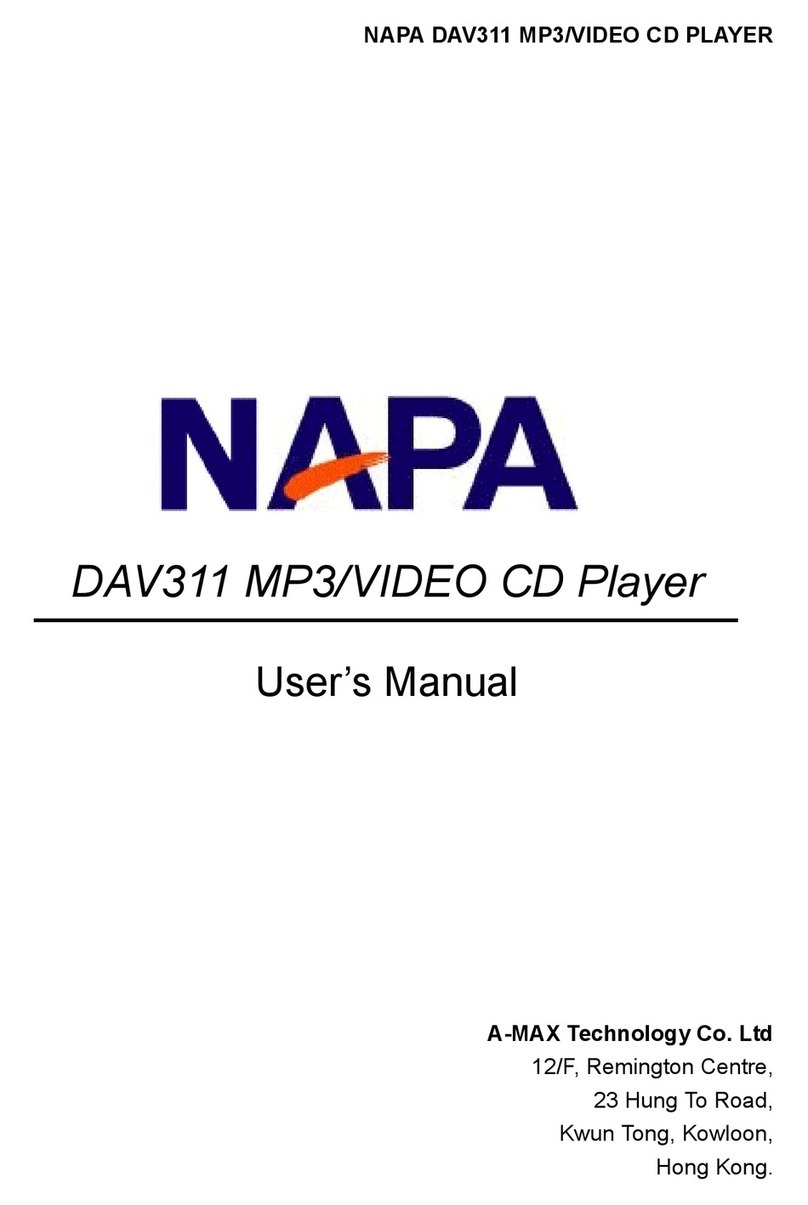
A-MAX Technology
A-MAX Technology NAPA DAV311 user manual
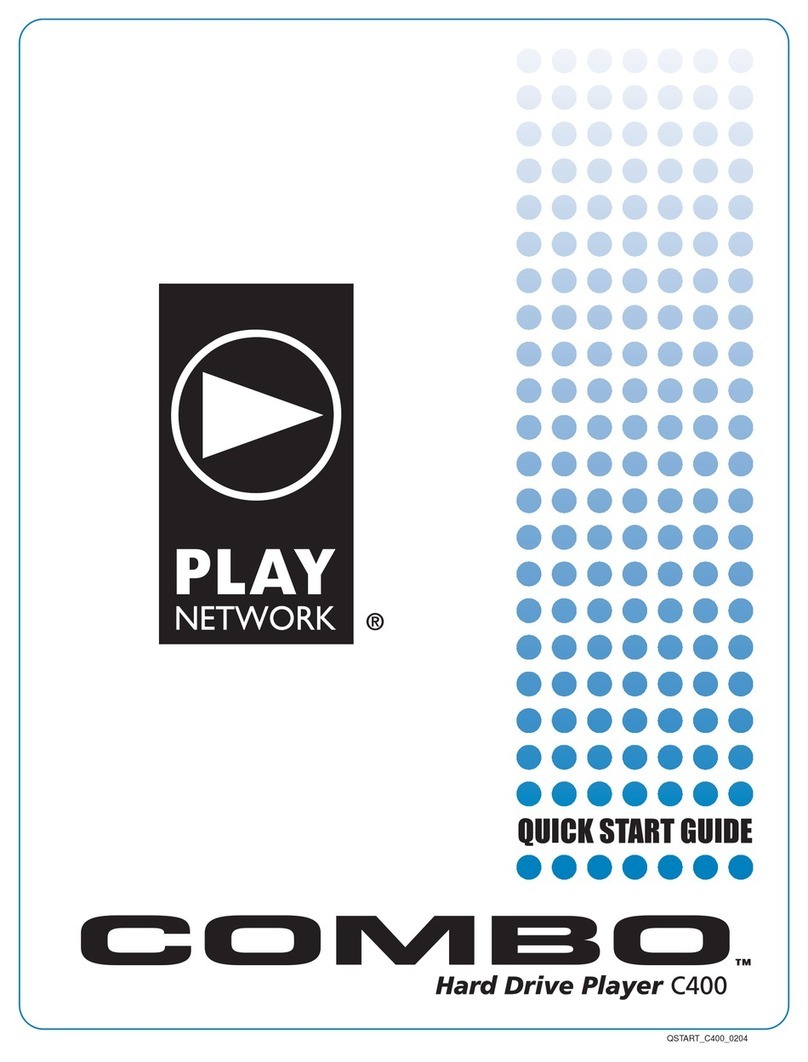
ESS
ESS C400 quick start guide
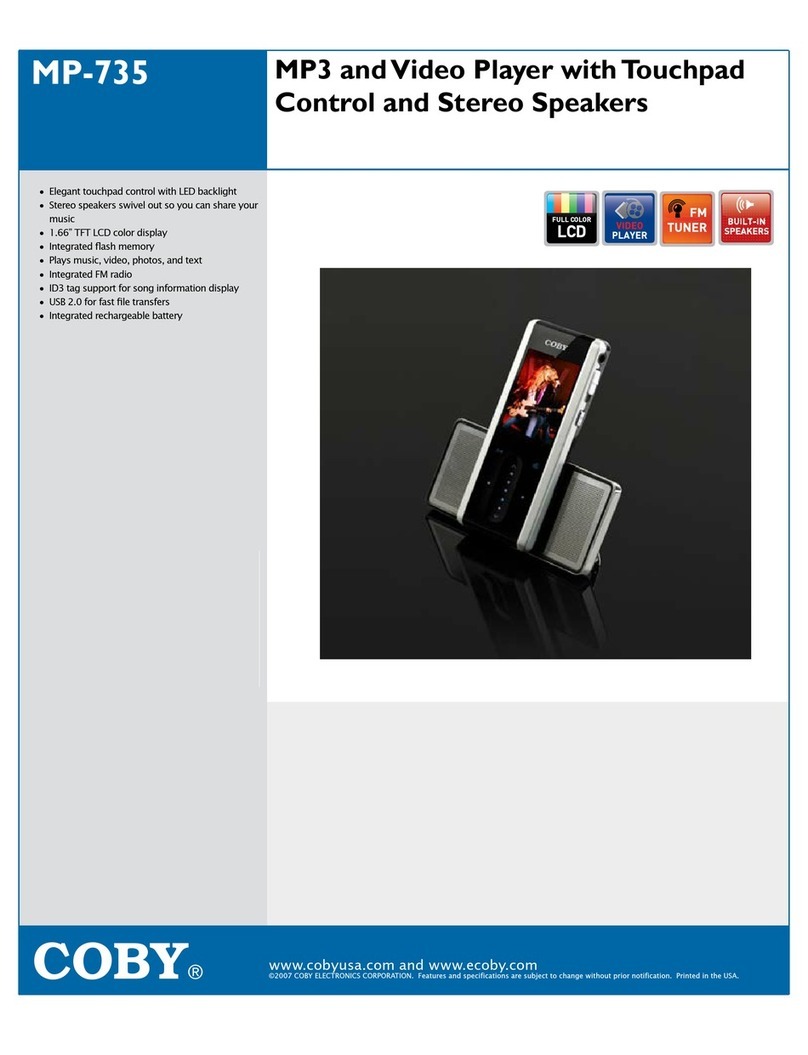
Coby
Coby MP-735 1GB Specifications

Memorex
Memorex NMP4101-SBS - Npower Fission SpongeBob 1 GB Digital... user guide
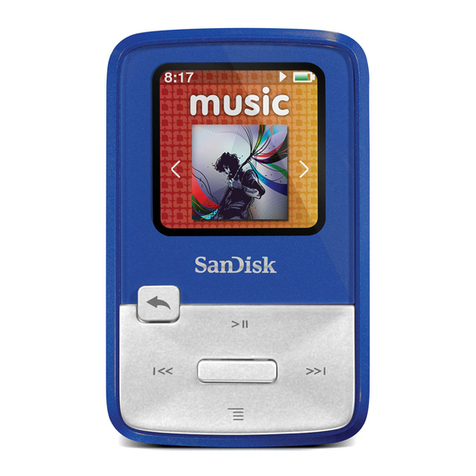
SanDisk
SanDisk Sansa Sansa Clip Zip 4GB user guide
